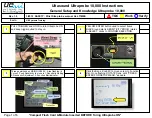
38
PSR-S670 Reference Manual
2
St
yles
NTR (Note Transposition Rule)
NTT (Note Transposition Table)
When NTR is set to ROOT TRANS or ROOT FIXED
ROOT TRANS
(Root Transpose)
When the root note is transposed, the interval
between notes is maintained. For example, the notes
C3, E3 and G3 in the key of C become F3, A3 and
C4 when they are transposed to F. Use this setting for
channels that contain melody lines.
ROOT FIXED
The note is kept as close as possible to the previous
note range. For example, the notes C3, E3 and G3 in
the key of C become C3, F3 and A3 when they are
transposed to F. Use this setting for channels that
contain chord parts.
GUITAR
This is exclusively for transposing guitar accompaniment. Notes are transposed
to approximate the chords played with natural guitar fingering.
BYPASS
When NTR is set to ROOT FIXED, the transposition table used does not do any
note conversion. When NTR is set to ROOT TRANS, the table used only con-
verts the notes by maintaining the pitch relationship between notes.
MELODY
Suitable for melody line transposition. Use this for melody channels such as
Phrase 1 and Phrase 2.
CHORD
Suitable for chordal parts transposition. Use this for the Chord 1 and Chord 2
channels, especially when they contain piano or guitar-like chordal parts.
MELODIC MINOR
When the played chord changes from a major to a minor chord, this table low-
ers the third interval in the scale by a semitone. When the chord changes from a
minor to a major chord, the minor third interval is raised by a semitone. Other
notes are not changed. Use this for melody channels of Sections which respond
only to major/minor chords, such as Intros and Endings.
MELODIC MINOR 5th
In addition to the Melodic Minor transposition above, augmented and dimin-
ished chords affect the 5th note of the Source Pattern.
HARMONIC MINOR
When the played chord changes from a major to a minor chord, this table low-
ers the third and sixth intervals in the scale by a semitone. When the chord
changes from a minor to a major chord, the minor third and flatted sixth inter-
vals are raised by a semitone. Other notes are not changed. Use this for chord
channels of Sections which respond only to major/minor chords, such as Intros
and Endings.
HARMONIC MINOR
5th
In addition to the Harmonic Minor transposition above, augmented and dimin-
ished chords affect the 5th note of the Source pattern.
NATURAL MINOR
When the played chord changes from a major to a minor chord, this table low-
ers the third, sixth and seventh intervals in the scale by a semitone. When the
chord changes from a minor to a major chord, the minor third, flatted sixth and
flatted seventh intervals are raised by a semitone. Other notes are not changed.
Use this for chord channels of Sections which respond only to major/minor
chords such as in Intros and Endings.
NATURAL MINOR 5th
In addition to the Natural Minor transposition above, augmented and dimin-
ished chords affect the 5th note of the Source pattern.
DORIAN
When the played chord changes from a major to a minor chord, this table low-
ers the third and seventh intervals in the scale by a semitone. When the chord
changes from a minor to a major chord, the minor third and flatted seventh
intervals are raised by a semitone. Other notes are not changed. Use this for
chord channels of Sections which respond only to major/minor chords such as
in Intros and Endings.
DORIAN 5th
In addition to the Dorian transposition above, augmented and diminished
chords affect the 5th note of the Source pattern.
When playing
a C major
chord.
When playing
an F major
chord.
When playing
a C major
chord.
When playing
an F major
chord.
















































